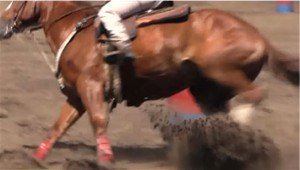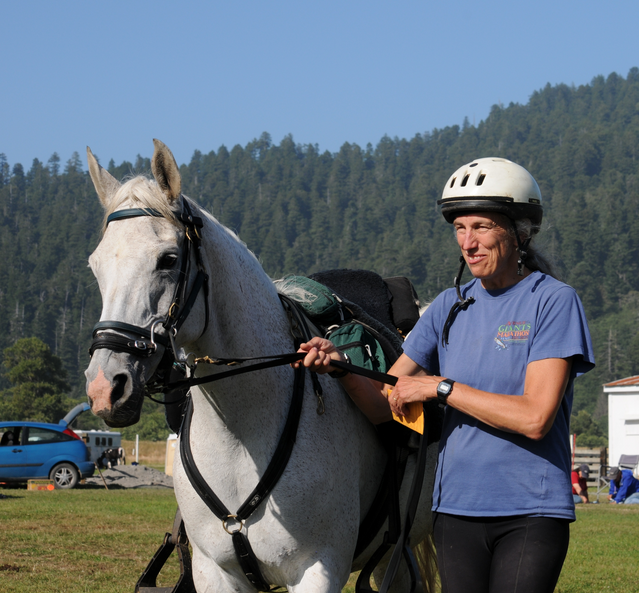Equine Chiropractic
With
Sue Thompson DVM
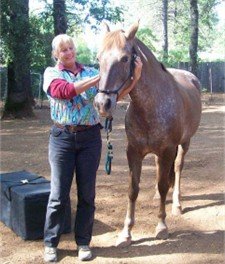 Equine Chiropractor Dr. Sue Thompson DVM
Equine Chiropractor Dr. Sue Thompson DVMMeet Sue Thompson DVM - Dr. Sue is a long time horse trainer, veterinarian and certified in small and large animal chiropractic. She currently practices at The Animal Hospital on the Ridge in Paradise, California.
Since receiving her equine chiropractic certification in 2007 she travels considerable distances providing referral services for fellow veterinarians, and much needed relief to her chiropractic patients.
Dr. Sue’s horse savvy and intimate knowledge of equine anatomy make the perfect combination for someone in the horse chiropractic business. It’s no wonder she’s been such a success!
Dr. Sue, for those of us that are unfamiliar with it, what exactly is equine chiropractic?
Chiropractic treatment of horses and other animals is not that much different than for humans. Difference in structure requires different techniques but the basics are the same.
Chiropractic is a diagnostic and treatment method used to address problems with bio-mechanics (motion) in stuck joints (what we call – subluxation complexes). The technique we use is called an adjustment. This is a small in amplitude (size), high energy, pulse through the working plane of the stuck joint to improve its motion. Traditional chiropractic is done by hand not instruments or tools.
As a horsemen yourself, you know how attached we get to our horses! I can see how some may be reluctant to try something unfamiliar when it comes to horse care. Is it possible for a horse to be injured by an equine chiropractic adjustment?
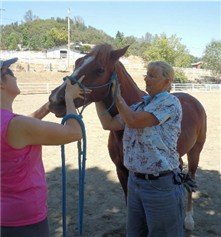 Dr. Thompson checks the movement in the horse's upper neck in an equine chiropractic exam.
Dr. Thompson checks the movement in the horse's upper neck in an equine chiropractic exam.Chiropractic when used by someone properly trained: including to recognize when it is an appropriate treatment method and when other medical tools or techniques should be used, is very safe for horses.
How long does the average equine chiropractic session take? And do the horses like it?
Treatment time and details will very with each practitioner and patient. My average 1st appointment is about a 45 min to an hour. Subsequent treatments usually take less time, as the patient gets better with fewer adjustments needed. You ask if they like it. They certainly seem too. If not actually like the process they like the results. Many of my patients especially the horses get bossy about their treatments.
What are some of the issues with horses that cause your clients to seek out an equine chiropractic treatment Dr. Sue?
That varies widely but it's everything from the regular vet can't find the source of lameness to behavioral problems to they just are a little off. A common comment is trouble with picking up a lead or they have gotten cinchy. The performance horses just aren’t working up to par. It might be that they are having trouble with saddle fit.
How can the average owner determine if their horse is in need of an equine chiropractic adjustment?
 Top view of an equine chiropractic adjustment done on one of Dr. Thompson's patients
Top view of an equine chiropractic adjustment done on one of Dr. Thompson's patientsThe best way is to have their horse examined by a qualified practitioner but short of that there are a few things to look for:
- Watch your horse walk from behind, ask yourself, is their motion symmetrical. The best place to focus is on the top of their hips or croup.
- Look at your horses shoulders, are they muscled evenly, the same on both sides. Do you feel like you are always slipping off one side or can’t get your saddle to sit straight?
- Can they bend equally and symmetrically in both directions?
- Is your horse girthy or resistant to saddling or flinches when brushed?
- Is there something that they can’t do now that they used to be able to do easily? Pick up a lead or change leads both directions?
- Is their back flat? Lack muscle on their top line? Do they have a hunters bump, a raised area on their back in their lumbar area?
What are the benefits of using equine chiropractic vs. training or other methods to solve problems with horses?
If your horse has a true lameness that first needs a medical diagnosis. That said if we are looking at a lameness problem, compensating for that injury often causes trouble in other places in the system. (Think about walking with a limp and the stress it puts on your back and other leg)
If a horse has a subluxation complex, a chiropractic problem, stretching or training can increase the risk of injury and only increases imbalance in their muscles. This is detrimental in the long run as it takes longer to retrain and rebalance the system the longer it has been compensating for the stuck joint or joints.
If someone is interested in seeking out an equine chiropractor, what’s the best way to go about finding a qualified practitioner in their area?
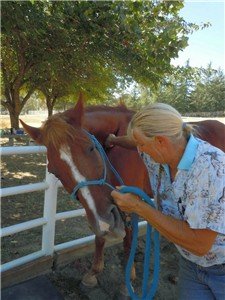 Notice how relaxed the horse is as Dr. Thompson makes an adjustment!
Notice how relaxed the horse is as Dr. Thompson makes an adjustment!There are 2 certifying agencies to check with:
1. American
Veterinary Chiropractic Association
2. International
Veterinary Chiropractic Association.
They both have “find a practitioner” functions on their websites. (I’m certified through the I.V.C.A.)
You can also go through one of the 3 recognized schools of animal chiropractic:
- Options for Animals (my alma mater)
- Healing Oasis
- Parker School of Chiropractic
These also have ways to find their equine chiropractic students in your area on their website.
We do not yet have a registration system for qualified practitioners through the California Veterinary Medical Board.
* I found Dr. Sue Thompson via my local Large Animal Vet Office.
I’m sure you have plenty of stories to tell, but would you mind sharing one of your most memorable equine chiropractic cases with us?
One of my favorite stories is about a big warmblood gelding that was being trained as a dressage horse but had been sent back by 3 different trainers as impossible to deal with.
He was a big horse and could be very intimidating and he was very self-protective.
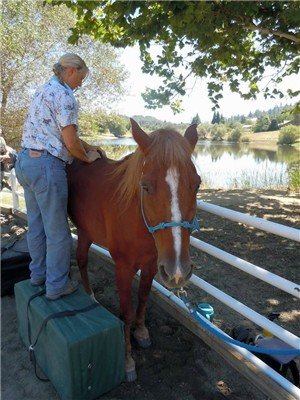 Dr Thompson attends to all parts of the equine spine.
Dr Thompson attends to all parts of the equine spine.This big horse was traveling in about 4 different directions all at the same time. He was a twisted mess. It took some patience and convincing to get him to let me work on him; but once he decided he could trust me, he started to help me.
He would position himself for the next adjustment and stood rock still instead of dancing around. When I was done, he put his head down on my shoulder and pulled me into his chest in a big horse hug. He could actually walk a straight line as he went back to his barn.
I worked with him a few times and the last I heard he was doing well in training. His behavior issues have mostly gone by the wayside. I have had this type of response from several incorrigible horses now over the years, but he was the first one that responded so dramatically.
Wow, that’s a beautiful story. I believe it is so important for people to realize there are other options for fixing their horses 'issues'. Thank you so much for taking the time from your busy schedule to share this information with us Dr. Sue!
Dr. Sue Thompson also adjusts small animals as well. She has many canine patients.

A True Story About One of Dr. Sue Thompson's Patients
Magic was a young three year old when his current owner Debra Selberg got her hands on him. Magic had received little to no training or handling at that point and was willing but physically unable to do what the trainer was asking of him due to his injuries (of which no one knew for sure the origin, although a pasture accident became the assumption).
He was very standoffish and spooky, which is unusual for his happy-go-lucky Rocky Mountain breed. His trust had to be earned. When Sue Thompson, a phenomenal equine chiropractor, began seeing Magic his entire demeanor transformed. He became trainable and happy and worked very well in training. He responded amazingly to chiropractic work and transformed.
His chiropractic adjustments started out as a weekly affair and today he can go several months without getting adjusted. He is a wonderful testimony to the benefits of chiropractic medicine in animals (horses especially), today he will refuse to be worked if he is hurting and Debra knows that’s when she has to make an appointment with Sue to get him adjusted.
Sue has found that horses and other animals that receive these treatments begin to understand the logistics of it and will use their bodies in sync with her hands to help her adjust them. She says, somewhat jokingly, that when she pulls up to the barns where she adjusts a lot of horses that commotion uproars and the horses verbally fight for her attention and dibs on who gets to get adjusted first.
The following short story is an artistic take on Magic’s true experience and his transformation due to chiropractic medicine.
Click to read Magic's Story
Do you know a horse that could benefit from this kind of equine chiropractic care? Share this page with your horse owning friends. It's easy, just use the social buttons below. The horses will thank you!
Other Horse Talk Interviews You May Enjoy:
Home > Horse Talk > Equine Chiropractic with Sue Thompson DVM

